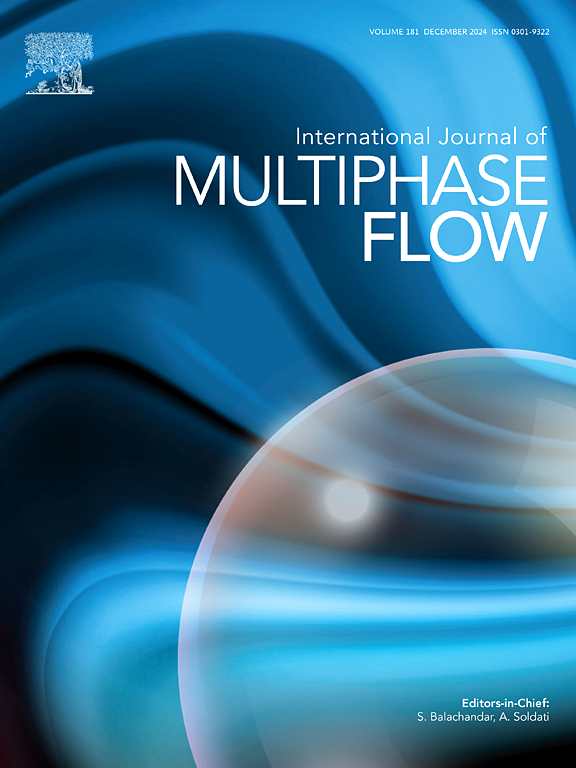Numerical analysis of particle deposition during normal impact of diluted suspension droplets
IF 3.8
2区 工程技术
Q1 MECHANICS
International Journal of Multiphase Flow
Pub Date : 2025-09-17
DOI:10.1016/j.ijmultiphaseflow.2025.105452
引用次数: 0
Abstract
Suspension droplet wall impacts are important for numerous technical applications, as for example spray painting in automotive industry, layering in material science, erosive surface cleaning and pharmaceutical coatings. Therefore, a numerical framework for the investigation of suspension droplet impact processes based on the coupling between the Volume of Fluid (VOF) method and a Lagrangian Particle Tracking (LPT) algorithm is implemented in OpenFOAM. A dynamic contact angle model is used to account for contact angle hysteresis effects during the impact process, with advancing, receding and equilibrium phases, coupled with a partial-slip boundary condition. Particle deposition at the substrate is modelled considering energy balances accounting for the adhesive van der Waals force acting at the particle-substrate interface. Three dimensional simulations are carried out to analyse the effects of impact conditions for the impingement of diluted water suspension droplets (diameter in the mm-range and Weber numbers in the range of 2.8 – 64.30) composed by micrometre-sized Polystyrene particles with a 0.5 % volume fraction onto a Polycarbonate substrate. The numerical results are validated by comparing the droplet’s spread factor and contact angle dynamics with own experimental data, obtaining a good agreement during the spreading phase of the impact. The influence of the droplet’s impact morphology on the particle distribution and particle-substrate interactions is discussed. A fixed impact condition test case is used to evaluate the influence of particle inertia on particle-substrate interactions by considering different particle size and density values, as well as distinct particle deposition models.

稀释悬浮液滴正常撞击时颗粒沉积的数值分析
悬浮液滴对壁面的冲击对许多技术应用都很重要,例如汽车工业的喷漆、材料科学的分层、腐蚀性表面清洁和制药涂料。因此,基于流体体积法(VOF)和拉格朗日粒子跟踪(LPT)算法之间的耦合,在OpenFOAM中实现了研究悬浮液滴撞击过程的数值框架。采用动态接触角模型,考虑了碰撞过程中接触角的滞后效应,包括前进、后退和平衡阶段,并结合部分滑移边界条件。粒子沉积在基材上的模型考虑了能量平衡,考虑了作用在粒子-基材界面上的粘接范德华力。采用三维模拟方法,分析了由体积分数为0.5%的微米级聚苯乙烯颗粒组成的稀释悬浮液(直径在mm范围内,韦伯数在2.8 ~ 64.30范围内)撞击聚碳酸酯基板的影响。通过将液滴扩散系数和接触角动力学与自身实验数据进行比较,验证了数值计算结果,得到了较好的吻合。讨论了液滴的冲击形貌对颗粒分布和颗粒-基体相互作用的影响。考虑不同的颗粒尺寸和密度值,以及不同的颗粒沉积模型,采用固定的冲击条件测试案例来评估颗粒惯性对颗粒-基质相互作用的影响。
本文章由计算机程序翻译,如有差异,请以英文原文为准。
求助全文
约1分钟内获得全文
求助全文
来源期刊
CiteScore
7.30
自引率
10.50%
发文量
244
审稿时长
4 months
期刊介绍:
The International Journal of Multiphase Flow publishes analytical, numerical and experimental articles of lasting interest. The scope of the journal includes all aspects of mass, momentum and energy exchange phenomena among different phases such as occur in disperse flows, gas–liquid and liquid–liquid flows, flows in porous media, boiling, granular flows and others.
The journal publishes full papers, brief communications and conference announcements.

 求助内容:
求助内容: 应助结果提醒方式:
应助结果提醒方式:


